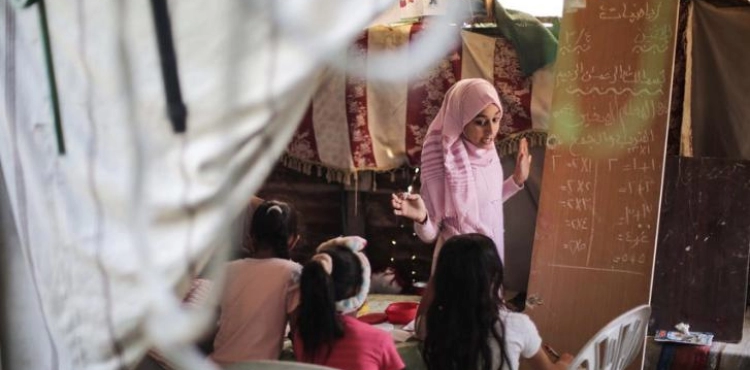Children in a small village in the Gaza Strip are missing the seats that they have been discontinuing for more than two months as a precautionary measure to prevent the outbreak of the new Corona virus (Covid-19).
Therefore, children gather daily in the village of Al-Mughraqa in a narrow tin room to review the lessons in the hope that the new Corona disease crisis will end soon and school activities will resume as normal.
The child, Fajer Hamid, 13, is a professor in the daily lessons of her peers inside the room, which has turned into a semester sufficient to accommodate about 20 children in each academic period.
Hamid uses one of the old wardrobe doors as the blackboard on which to write lessons.
It offers classes for children from grades one to seven in two periods, including the basics of the Arabic language and some other educational curricula such as mathematics and English.
Hamid says that the length of school absenteeism may adversely affect students´ retention of information previously obtained.
She adds that they are trying to keep in touch with the atmosphere of study and not to forget the lessons in light of the continued closure of schools.
Schools and universities have been closed within the imposition of a state of emergency in the Palestinian territories since the beginning of last March, following the discovery of the first cases of the new Corona virus in the city of Bethlehem.
The Gaza Strip, with a population of about two million people, recorded on March 22 the discovery of the first two cases of the new Corona virus, of two travelers returning from Pakistan.
The number of injuries in the Gaza Strip has reached 20 so far, most of them recovering.
Al-Mughraqa is considered one of the marginalized villages in the besieged Gaza Strip, since the middle of 2007.
The area of ​​the village is about 3,260 dunums, and it is inhabited by about 8,500 people, the majority of whom suffer from poverty and depend on receiving government food aid and international organizations.
There is only one school in the village.
According to Hamid, children have to reach school on foot for at least 1.5 km, to enroll in their classes.
She points out that the period of students for a long time at home in light of the closure of schools, negatively affected their psychological state, as it overcomes many of them manifestations of violence and playing on the streets continuously.
The child, Hamid, uses methods of promotion and encouragement for children who live in their classroom, by purchasing candy bars from their daily expenses and distributing them as symbolic prizes for their positive interaction during the class.
In addition, Hamid relies on giving her students an opportunity to express their feelings through the arts and drawings class, by distributing colors and white papers to them in order to draw on them.
For her part, Luma Al-Shorbaji, 9, is committed to attending all classes given by her friend Fajr, where she constantly interacts with her young teacher and participates in answering her questions.
Al-Shurbagi says she is waiting impatiently for the morning to come to her new class, especially as he is close to her home and will not have to walk a long distance to reach it.












